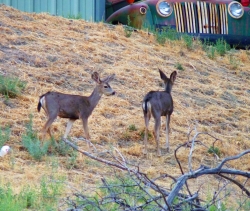By Joan Casanova, Green Earth Media Group
October 13, 2010 (San Diego’s East County) -- With fall and winter right on our heels, you may think you’re out of the woods when it comes to deer damage in your backyard landscapes. Wrong. Actually, fall and winter mark the beginning of the worst seasons for deer damage. Deer will eat just about anything in the winter -- their food supply is low and they can’t be choosy. They are hungry enough in the winter to eat vegetation that they ordinarily would not eat.
As with other wildlife, land development has reduced deer’s natural habitat. Combine that with fewer natural predators than in the past and easy access to your landscapes, and modern-day deer not only survive, they thrive!
The most important thing to understand about fighting deer is that it’s easier to prevent damage than to react to it. So it behooves you to know your enemy and stay at least one step ahead of them. Deer are creatures of habit -- they establish feeding patterns and return to the same spot over and over again, even when that same spot stops offering enough food for them.
Even just a few deer can cause significant damage to your landscaping. “A single whitetail deer can consume, on average, 8 -12 pounds of foliage a day,” says James Messina of Messina Wildlife Management. “In many areas of the country, deer overpopulation is a serious problem. With nowhere to go and not much left to eat in the dead of winter, deer can wreak havoc on shrubs, trees and gardens, and destroy new buds and leaves before they have a chance to grow, ruining your prospects for any spring growth.”
Messina says you can be sure deer have been munching on your landscapes this fall and winter if you see:
1. Rub marks on trees where bucks have rubbed their antlers to mark their territory; the tree bark is actually rubbed off.
2. Any kind of torn vegetation is also another telltale sign, deer do not have incisor teeth, and therefore, they “rip” the vegetation when they bite into it.
3. Damage found off the ground, up to 6 feet, which rules out small animal damage.
4. Deer tracks are also easy to identify. The prints are about 2 to 3 inches long and are shaped like broken hearts.
 So what do you do to keep the deer out of your backyard? There are loads of “home remedies” that have been tried with varying results--human hair, soap, pepper spray, even a battery operated radio, sealed in a plastic bag, tuned to a talk radio station fooling deer to think humans are in the yard! These remedies might work sporadically, but they are not reliable deterrents for deer.
So what do you do to keep the deer out of your backyard? There are loads of “home remedies” that have been tried with varying results--human hair, soap, pepper spray, even a battery operated radio, sealed in a plastic bag, tuned to a talk radio station fooling deer to think humans are in the yard! These remedies might work sporadically, but they are not reliable deterrents for deer.
Then there’s fencing. Properly built and maintained fencing can be an effective method for preventing deer damage. But, deer can jump up to and clear an 8-foot fence on level ground, and they can easily push and remove plastic netting. Installing a 6- to 8-foot fence can be an effective solution to some extent, but fencing is costly and can be quite unsightly.
Perhaps one of the most effective and easiest methods to deter deer is repellents. Deer repellents are designed to impart objectionable odors or tastes. Most are not allowed on food crops. Some repellents can also be injurious to certain trees or shrubs, and especially to new growth.
Now Messina Wildlife Management (www.messinawildlife.com) offers Deer Stopper, a 100-percent organic repellent, that works by both smell and taste. You won’t have to worry about burning your plants or using it on edibles. Deer Stopper is actually pleasant smelling, but the deer find it unpleasant enough to keep away. The product dries clear and odor free. Deer Stopper is ideal for winter protection: if plants are covered by snow, it can be applied directly to the snow to prevent digging and foraging. As the snow melts, the product will bind to the plants and bulbs below the earth.
Deer Stopper is listed for use by organic growers, meaning it is safe to use on any vegetation, including edibles. It is an all-natural, biodegradable liquid repellent that guarantees deer will stop feeding on your prized gardens, shrubs and trees for 30 days per application.
This winter protect your plants and shrubs and create your own boundaries for foraging deer. Now you’re in control, just spray Deer Stopper and watch those doggone deer disappear from your backyard landscapes.
For more information on Deer Stopper, retail store locations and repellents for other garden pests like rabbits, groundhogs and squirrels, visit www.messinawildlife.com.







Recent comments